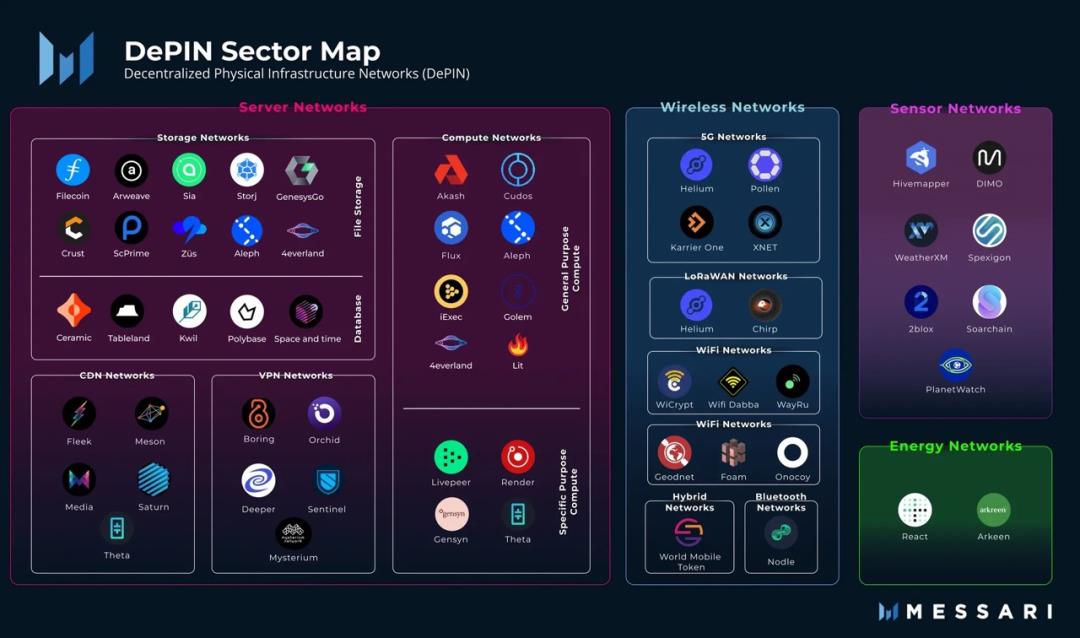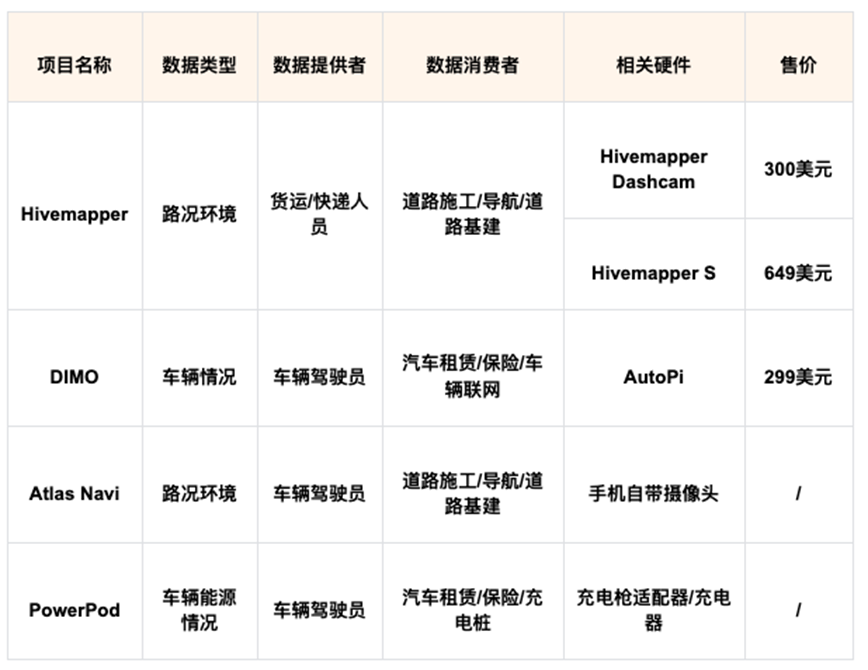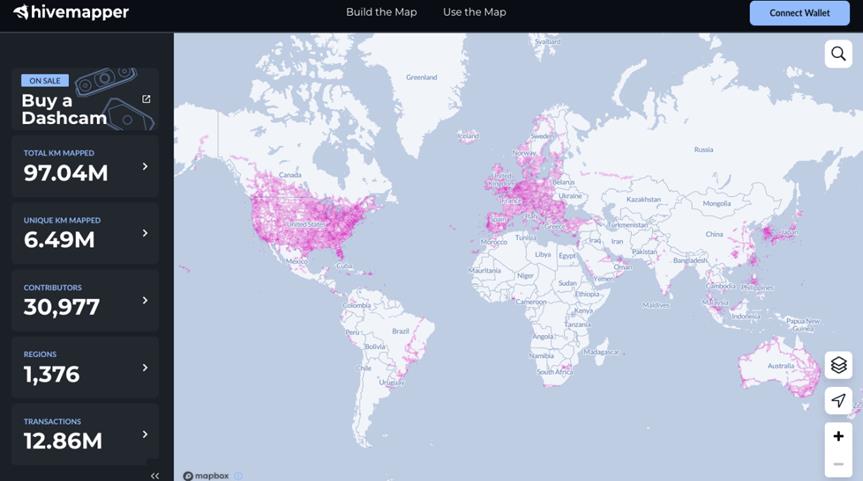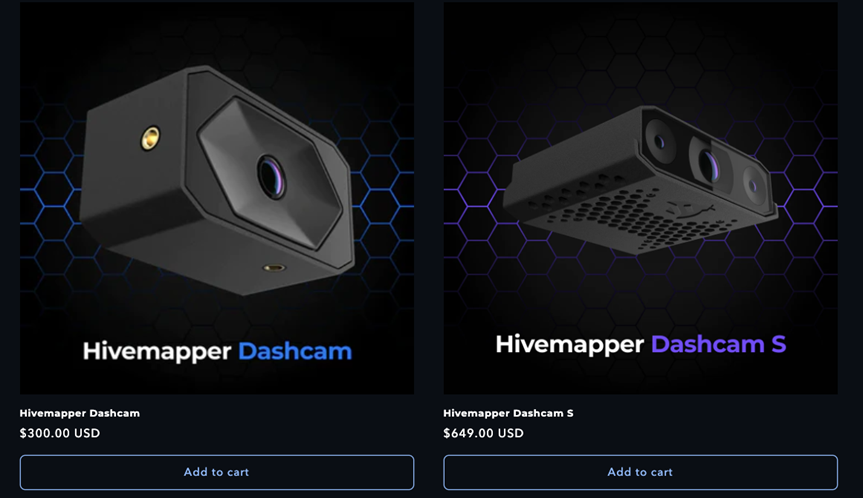The real world will be integrated with Web3, and the mass adoption pursued by Web3 is also on the way.
TL; DR
Huge Potential in the Global Automobile Market: The global number of automobiles has exceeded 1.6 billion, but only 250 million are connected to the internet;
We can call this paradigm "Drive To Earn," or "DeDrive";
DePIN Completes the Coupling of the Real World and the On-Chain World from the Bottom Up: Almost all DePIN projects related to automobiles are backed by real-world income, and the token economy is organically integrated as a driving force tool and product system.
DePIN & Drive To Earn
The term "DePIN" was proposed by Messari, referring to Decentralised Physical Infrastructure Networks. Messari divides the DePIN track into four major sectors: service networks, wireless networks, sensor networks, and energy networks.

If divided by hardware form, it can be roughly categorized into three types: computers, storage, and general applications.
The general applications category includes hardware devices such as familiar wireless routers and dash cams. For C-end users, there is a natural demand for a better hardware experience, and for B-end customers, there is a need to optimize product intrinsic driving force through more accurate data collection. Therefore, we can see that around the mobile phone, HONEY, and DIMO centered around automobiles have seen promising trends based on DePIN. Among them, the ecosystem centered around data collection and decentralized supporting services for automobiles is particularly prominent.
On one hand, this is because automobiles are the most relevant assets for general users globally and have a wide audience. As of now, the global number of automobiles has exceeded 1.6 billion, and based on the global population of 7 billion, on average, every 4 people own one car. These vehicles travel on over 64 million kilometers of roads worldwide.
However, at the same time, statistics show that globally, road traffic accidents cause 1.3 million deaths annually, with 90% occurring in low- and middle-income countries. Compared to the number of vehicles and roads in these countries, the death rate is disproportionately high.
The demand from both C-end users and B-end users in the automobile field is more urgent.
Concept of Internet of Vehicles and DeDrive
On the other hand, with the widespread development of the Internet of Things concept, the concept of "Internet of Vehicles" using automobiles as carriers to build smart facilities has also gained global attention and capital.
The concept of Internet of Vehicles partially solves the problem of automobile data collection, but due to the excessive centralization of related enterprises, and different manufacturers striving to build moats, as well as the customization of case development, it is not conducive to the dilution of R&D costs for enterprises. The cost is ultimately transferred to consumers, which to some extent limits the development of "automobile networking."
With the rise of blockchain concepts and DePIN, "introducing blockchain technology and cryptocurrency elements to related equipment manufacturers, helping manufacturers to complete the capital flywheel more quickly, and providing tokens to attract a wider range of user groups for co-construction, and allowing users to profit from it" has gradually become the consensus in the context of Web3.
We can call this paradigm "Drive To Earn," or "DeDrive."
Currently, the main representatives of DeDrive projects are Hivemapper and Dimo, and Future Money Group will organize around these two projects and related projects associated with Drive.
DeDrive Concept Projects

Hivemapper

HiveMapper is one of the top DePin concepts on Solana, creating a decentralized "Google Maps." Users who purchase the dashcam launched by HiveMapper and share real-time images with HiveMapper can earn HONEY tokens.
HiveMapper uses the map and road condition information collected from special user groups such as logistics and surveying companies to create an API interface to provide services to B-end or C-end users in need.
Compared to Google Maps, through token incentives, HiveMapper can ensure the enthusiasm and accuracy of information collectors, and due to the existence of tokens, the company does not have a large operating expense pressure. Instead, it can provide B-end with cheaper and more cost-effective API services to achieve overtaking on the bend.
In fact, as an alternative to the Google Maps API, millions of companies rely on the Google Maps API to support their location data, and the price of this service has risen significantly in recent years.
As a challenger to Google Maps, HiveMapper theoretically has a potential market value at least equal to that of Google Maps.
HiveMapper Network has two main components:
- Dashcam: An internally open-source dashcam that can collect 4K images and related GPS metadata, including LoRa sensors, using Helium's IoT network to verify location.
Currently, there are two versions of the HiveMapper dashcam: the HiveMapper Dashcam (priced at $300) and the S version (priced at $649). The former is suitable for standard surveying and can shoot up to 4k 10fps, while the latter is smaller and more discreet, and can shoot up to 4k 30fps.

- HiveMapper Contributor Application: This application pairs with the dashcam via Wi-Fi to transfer images and location data from the dashcam to the user, and the application transfers the data from the device to the map network for processing.
Token Economy: The HONEY token has a fixed maximum supply of 10 billion, distributed as follows:
• 40% to contributors as a reward for contributing map data;
• 20% to investors as initial funding for the mainnet launch;
• 35% to HiveMapper employees for daily operation and iteration of the mainnet;
• 5% to the foundation to promote the management and success of HiveMapper.
The HONEY token is used to create economic incentives in the HiveMapper network, while balancing the needs of the two groups within the ecosystem:
Map data contributors: HONEY serves as a reward for submitting information, editing map data, and completing AI training tasks.
Enterprises and developers using map data to support their products and services: HONEY serves as a consumption cost when calling HiveMapper network data.
Overall, the on-chain market between contributors and customers in the HiveMapper network is created through Burn & Mint deconstruction, where HONEY burned by customers when using API services is minted as a reward and given to contributors as the demand for map usage increases, the speed of HONEY destruction and recasting will also accelerate.
Currently, HiveMapper has drawn road condition information for a total of 96 million kilometers in 1376 areas through over 30,000 contributors worldwide, generating nearly 13 million transactions based on this information.
Dimo
Dimo is a car IoT platform built on Polygon that allows drivers to collect and share their vehicle data, including mileage, speed, location tracking, tire pressure, and battery/engine health.
If HiveMapper focuses on external environmental data for cars, Dimo focuses on internal driving data.
By analyzing vehicle data, the Dimo platform can predict when maintenance is needed and promptly alert users. In this way, drivers can not only gain a deeper understanding of their vehicles but also contribute data to Dimo's ecosystem to earn DIMO tokens as rewards. Data consumers can extract data from the protocol to understand the performance of components such as batteries, autonomous driving systems, and controls. This will help develop disruptive new applications for fine-grained insurance, ride-hailing, traffic navigation, vehicle financing, and energy network optimization.
With approximately 1.6 billion cars globally, only about 250 million are connected to the internet. This presents a huge development space for Dimo. Similar to HiveMapper, Dimo's product includes hardware devices and an app.
The hardware device, called AutoPi (priced at $299), can be plugged into cars to enable internet connectivity for all cars produced after 2008. Once connected, users can monitor their car's performance and health data in real-time on the app and earn DIMO token rewards in the process.
Token Economy: DIMO is the native token of the Dimo protocol, used to reward users and contributors.
The token supply is 1 billion, with the following distribution:
• 38% for baseline issuance, with 380 million DIMO distributed over 40 years, starting at 1,105,000 DIMO per week in the first year and decreasing by 15% annually;
• 22% for the Dimo treasury, for individuals and teams contributing to the network, possibly receiving DIMO as bounties or grants;
• 22% for the team, with a two-year lockup period for token distribution, followed by linear unlocking monthly until fully unlocked after three years;
• 8% for investors, with a two-year lockup period for token distribution, followed by linear unlocking monthly until fully unlocked after three years;
• 7% for airdrops.
Currently, DIMO has four main functions:
- Reward distribution: Users can earn DIMO tokens in two ways.
Baseline issuance reward: Users can earn DIMO tokens as long as they are connected to the product, even if the end customer does not use the corresponding data.
Market issuance reward: Users receive additional DIMO tokens when transacting with authorized DIMO applications. The quantity and terms of the reward are specified by the application developer.
Demand for transactions: Token holders can use DIMO to purchase and sell vehicle data and the Dimo AutoPi connection device.
Governance rights: DIMO token holders can vote on the operation of the protocol, including but not limited to software code upgrades, protocol and standards; how fees are generated, and how rewards are distributed.
Community membership: Token holders can access special application features and activities.
Currently, nearly 28,000 cars are connected to the Dimo network, with a total accumulated mileage of over 153 million kilometers. There are 71 car brands connected to Dimo, with Tesla, Ford, and BMW in the top three. Over the past year, over 57 million DIMO tokens, worth approximately $13 million, have been distributed to users. The estimated value of each car on the network adds up to over $750 million.
Atlas Navi
Atlas Navi is the first Drive to Earn navigation application using artificial intelligence. The smartphone camera detects road conditions (closed, road construction, potholes), accidents, traffic in each lane, available parking spaces, police cars, and reroutes drivers to avoid problematic roads and traffic congestion. It rewards those who provide camera data (optional) for every mile driven with licensed 3D NFT vehicles.
The token economy of Atlas Navi consists of three parts:
Vehicle NFT: Only users holding NFTs can earn MILE through the Atlas Navi product and convert it to NAVI.
MILE: A point-based token used to record user driving mileage when using the product and can be converted to NAVI by holding NFTs.
NAVI: The native token of the Atlas Navi ecosystem, used for user Drive to Earn rewards and payment for official NFTs and service subscriptions.
The total supply of NAVI tokens is 300 million, with the following distribution:
• 30% for user incentives
• 9% for the team
• 10% for the development team
• 10.67% for the marketing department
• 13% for initial liquidity
• 5% for the advisory team.
These are currently three of the most popular DeDrive projects with promising token trends. In fact, there are many other DePIN products focused on automobiles, such as Moveo, which focuses on car networking and insurance technology through custom vehicle hardware and patented software technology to provide innovative services.
Alternatively, Soarchain: Soarchain is an application-based blockchain on Cosmos, aiming to provide direct and fast data transmission services between vehicles, infrastructure, and networks. On Soarchain, vehicles share data with each other through cellular technology, recording this data on the blockchain and rewarding users with Soarchain's native tokens for these actions. The platform allows vehicles to contribute to the vehicle network anonymously and privately, maximizing their benefits through applications running on the network and receiving rewards.
In addition, there are DePIN projects focused on the car charging business, such as PowerPod.
PowerPod
PowerPod is a global electric vehicle (EV) charging network designed to quickly form and maintain low maintenance costs through a decentralized organizational structure, GameFi gameplay, and a positive revenue model. The network is owned by individuals and communities, avoiding the various problems associated with centralized management. Blockchain technology is used to ensure data security and transaction transparency within the network. The latest charging technology ensures safe, efficient, and highly compatible charging and provides a variety of personalized and intelligent services. In the future, the PowerPod network is expected to become an extension and complement to the traditional power grid, forming a new power supply network together with the power grid.
PowerPod will produce a series of smart hardware to ensure measurable, calculable, and reliable charging behavior.
The first phase will focus on charging gun adapters. By adding detachable adapters to the top of charging piles that cannot share data, critical data during the charging process can be accurately captured and securely sent to the blockchain. Blockchain-based contracts will calculate this data to incentivize positive behavior.

The second phase of hardware will be high-performance home AC chargers.
The third phase of hardware is the "mobile charger," allowing vehicle owners to use regular sockets for emergency charging (current of 10-16A).
Token Economy: PowerPod adopts a token model similar to Hivemapper and Dimo: points + tokens.
Within PowerPod, PT is a point-based currency generated algorithmically based on various incentivized positive behaviors (for example, charging 1 kW with a PowerPod smart charger earns 1 PT reward).
Another token, PPD, is the native and governance token of the ecosystem.
The total supply of PPD is 100 million, with 12.5 million produced in the first year, halving every 4 years. The distribution is as follows:
• 45% of PPD is allocated for incentivized positive behavior;
• 15% is allocated to developers;
• 18% is allocated to investors;
• 2% is allocated to advisors;
• 20% is allocated to the ecosystem.
In addition, the PPD used for mining will be aggregated into a dividend pool. Dividends are distributed every 12 hours based on the proportion of PT input to the total. Once PT is transferred to the dividend pool, it cannot be withdrawn, and after the dividend is distributed, the batch of PT in the pool will be destroyed.
For example, if user John transfers 100 PT to the dividend pool, at the end of the dividend period, there are a total of 10,000 PT in the dividend pool. Based on a 1% ratio, he will receive 77 PPD from the accumulated dividends in the pool for that period (assuming a distribution of approximately 7706 PPD for the first year). After distribution, all 10,000 PT in the pool will be destroyed.
Difference Between DeDrive and Move to Earn
At first glance, DeDrive concept projects and Move to Earn projects, represented by Stepn, appear similar in terms of token output. However, they are fundamentally different. While both have a similar role in expanding the Web3 concept, using behavior incentives to permeate the Web3 trend in a more understandable way, projects like Stepn's X to Earn are more driven by token economics and aim to maintain the Ponzi system by attracting more potential users. On the other hand, DeDrive projects are based on real entities and represent the recognition of blockchain technology and decentralized governance by tech companies.
We can see that almost all the cases mentioned above are based on real-world revenue as a foundation, with token economics as a driving force and an organic integration into the product system.
We can understand that if projects like Stepn's X to Earn represent and validate the paradigm of earning income on the chain through human behavior and verification, then DeDrive projects, represented by Hivemapper, have coupled the real-world entity with the on-chain world from the user level. The former influences the economic foundation from top to bottom, while the latter builds the foundation needed for the superstructure from the bottom up.
Conclusion
DePIN or DeDrive projects related to automobiles are further deepening the connection between the traditional world and the Web3 world. For example, Dimo's founder, Andy C, has interpreted the idea of creating a DMV based on his own network and putting vehicle ownership on the chain. If this step is realized, the on-chain system will truly enter the real world on a large scale. Data is valuable, and the contributions of every participant in the DePIN ecosystem should receive more valuable analysis and utilization, unleashing greater value.
In the future, the DePIN paradigm, represented by automobiles, will further expand into related fields (which has a greater impact than DePIN projects related to mobile phones), such as the vehicle insurance market, used car sales market, parts maintenance, road construction, and car rentals. At that time, the real world will be integrated with Web3, and the mass adoption that Web3 has been pursuing will also arrive.
We have every reason to be optimistic about the prospects of DePIN, but before the DePIN era truly arrives, DeDrive may lead the way and become one of the most popular targets in the market.
免责声明:本文章仅代表作者个人观点,不代表本平台的立场和观点。本文章仅供信息分享,不构成对任何人的任何投资建议。用户与作者之间的任何争议,与本平台无关。如网页中刊载的文章或图片涉及侵权,请提供相关的权利证明和身份证明发送邮件到support@aicoin.com,本平台相关工作人员将会进行核查。




